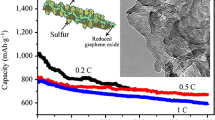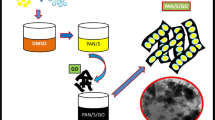Abstract
Graphene nanoplatelet (GnP), which consists of small stacks of graphene, is used as a reinforcement to enhance the performance of the poly(acrylonitrile-butyl acrylate) (PANBA) binder in a lithium ion battery (LIB). To the best of our knowledge, this is the first time that a conductive nanofiller such as GnP has been used in a conventional water-dispersed polymer and applied as a binder for LIB. Our so-called PANBA/GnP nanocomposites are made with either 0.5 wt%, 1 wt%, or 2 wt% of GnP. The nanocomposites are synthesized via an in situ emulsion polymerization technique and are very well-dispersed, homogeneous, and stable for at least 6 months. The elongation and electrical conductivity of the PANBA/GnP nanocomposites exceed those of the PANBA non-filled polymer, and the PANBA/GnP nanocomposite binder ultimately enhances the electrochemical performance of the high-capacity silicon/graphite mixture anode.
Graphical abstract







Similar content being viewed by others
References
Lee B-R, Oh E-S (2013) Effect of molecular weight and degree of substitution of a sodium-carboxymethyl cellulose binder on Li4Ti5O12 anodic performance. J Phys Chem C 117:4404–4409. https://doi.org/10.1021/jp311678p
Lestriez B, Bahri S, Sandu I et al (2007) On the binding mechanism of CMC in Si negative electrodes for li-ion batteries. Electrochem Commun 9:2801–2806. https://doi.org/10.1016/j.elecom.2007.10.001
Buqa H, Holzapfel M, Krumeich F et al (2006) Study of styrene butadiene rubber and sodium methyl cellulose as binder for negative electrodes in lithium-ion batteries. J Power Sources 161:617–622. https://doi.org/10.1016/j.jpowsour.2006.03.073
Kierzek K (2016) Influence of binder adhesion ability on the performance of silicon/carbon composite as Li-ion battery anode. J Mater Eng Perform 25:2326–2330. https://doi.org/10.1007/s11665-016-2083-7
Wei L, Chen C, Hou Z, Wei H (2016) Poly (acrylic acid sodium) grafted carboxymethyl cellulose as a high performance polymer binder for silicon anode in lithium ion batteries. Sci Rep 6:19583. https://doi.org/10.1038/srep19583
Lee B-R, Kim S-j, Oh E-S (2014) Bio-derivative galactomannan gum binders for Li4Ti5O12 negative electrodes in lithium-ion batteries. J Electrochem Soc 161:A2128–A2132. https://doi.org/10.1149/2.0641414jes
Bie Y, Yang J, Nuli Y, Wang J (2017) Natural karaya gum as an excellent binder for silicon-based anodes in high-performance lithium-ion batteries. J Mater Chem A 5:1919–1924. https://doi.org/10.1039/C6TA09522D
Courtel FM, Niketic S, Duguay D et al (2011) Water-soluble binders for MCMB carbon anodes for lithium-ion batteries. J Power Sources 196:2128–2134. https://doi.org/10.1016/j.jpowsour.2010.10.025
Carvalho DV, Loeffler N, Hekmatfar M et al (2018) Evaluation of guar gum-based biopolymers as binders for lithium-ion batteries electrodes. Electrochim Acta 265:89–97. https://doi.org/10.1016/j.electacta.2018.01.083
Bigoni F, De Giorgio F, Soavi F, Arbizzani C (2017) Sodium alginate: a water-processable binder in high-voltage cathode formulations. J Electrochem Soc 164:A6171–A6177. https://doi.org/10.1149/2.0281701jes
Wu Z-Y, Deng L, Li J-T et al (2017) Multiple hydrogel alginate binders for Si anodes of lithium-ion battery. Electrochim Acta 245:371–378. https://doi.org/10.1016/j.electacta.2017.05.094
Ling L, Bai Y, Wang Z et al (2018) Remarkable effect of sodium alginate aqueous binder on anatase TiO2 as high-performance anode in sodium ion batteries. ACS Appl Mater Interfaces 10:5560–5568. https://doi.org/10.1021/acsami.7b17659
Kovalenko I, Zdyrko B, Magasinski A et al (2011) A major constituent of brown algae for use in high-capacity Li-ion batteries. Science 334:75–79. https://doi.org/10.1126/science.1209150
Porcher W, Chazelle S, Boulineau A et al (2017) Understanding polyacrylic acid and lithium polyacrylate binder behavior in silicon based electrodes for Li-ion batteries. J Electrochem Soc 164:A3633–A3640. https://doi.org/10.1149/2.0821714jes
Hu B, Shkrob IA, Zhang S et al (2018) The existence of optimal molecular weight for poly(acrylic acid) binders in silicon/graphite composite anode for lithium-ion batteries. J Power Sources 378:671–676. https://doi.org/10.1016/j.jpowsour.2017.12.068
Gendensuren B, Oh E-S (2018) Dual-crosslinked network binder of alginate with polyacrylamide for silicon/graphite anodes of lithium ion battery. J Power Sources 384:379–386. https://doi.org/10.1016/j.jpowsour.2018.03.009
Zhu X, Zhang F, Zhang L et al (2018) A highly stretchable cross-linked polyacrylamide hydrogel as an effective binder for silicon and sulfur electrodes toward durable lithium-ion storage. Adv Func Mater 28:1705015. https://doi.org/10.1002/adfm.201705015
Moretti A, Kim G-T, Bresser D et al (2013) Investigation of different binding agents for nanocrystalline anatase TiO2 anodes and its application in a novel, green lithium-ion battery. J Power Sources 221:419–426. https://doi.org/10.1016/j.jpowsour.2012.07.142
El Ouatani L, Dedryvère R, Ledeuil J-B et al (2009) Surface film formation on a carbonaceous electrode: influence of the binder chemistry. J Power Sources 189:72–80. https://doi.org/10.1016/j.jpowsour.2008.11.031
Papageorgiou DG, Kinloch IA, Young RJ (2017) Mechanical properties of graphene and graphene-based nanocomposites. Prog Mater Sci 90:75–127. https://doi.org/10.1016/j.pmatsci.2017.07.004
Lee C, Wei X, Kysar JW, Hone J (2008) Measurement of the elastic properties and intrinsic strength of monolayer graphene. Science 321:385–388. https://doi.org/10.1126/science.1157996
Marinho B, Ghislandi M, Tkalya E et al (2012) Electrical conductivity of compacts of graphene, multi-wall carbon nanotubes, carbon black, and graphite powder. Powder Technol 221:351–358. https://doi.org/10.1016/j.powtec.2012.01.024
Jeon I-Y, Choi H-J, Jung S-M et al (2013) Large-scale production of edge-selectively functionalized graphene nanoplatelets via ball milling and their use as metal-free electrocatalysts for oxygen reduction reaction. J Am Chem Soc 135:1386–1393. https://doi.org/10.1021/ja3091643
Araby S, Meng Q, Zhang L et al (2014) Electrically and thermally conductive elastomer/graphene nanocomposites by solution mixing. Polymer 55:201–210. https://doi.org/10.1016/j.polymer.2013.11.032
Kim JS, Yun JH, Kim I, Shim SE (2011) Electrical properties of graphene/SBR nanocomposite prepared by latex heterocoagulation process at room temperature. J Ind Eng Chem 17:325–330. https://doi.org/10.1016/j.jiec.2011.02.034
Yue L, Pircheraghi G, Monemian SA, Manas-Zloczower I (2014) Epoxy composites with carbon nanotubes and graphene nanoplatelets—Dispersion and synergy effects. Carbon 78:268–278. https://doi.org/10.1016/j.carbon.2014.07.003
Mittal G, Dhand V, Rhee KY et al (2015) A review on carbon nanotubes and graphene as fillers in reinforced polymer nanocomposites. J Ind Eng Chem 21:11–25. https://doi.org/10.1016/j.jiec.2014.03.022
Mohd Radzuan NA, Sulong AB, Sahari J (2017) A review of electrical conductivity models for conductive polymer composite. Int J Hydrog Energy 42:9262–9273. https://doi.org/10.1016/j.ijhydene.2016.03.045
Prolongo SG, Moriche R, Jiménez-Suárez A et al (2014) Advantages and disadvantages of the addition of graphene nanoplatelets to epoxy resins. Eur Polymer J 61:206–214. https://doi.org/10.1016/j.eurpolymj.2014.09.022
Li W, Dichiara A, Bai J (2013) Carbon nanotube–graphene nanoplatelet hybrids as high-performance multifunctional reinforcements in epoxy composites. Compos Sci Technol 74:221–227. https://doi.org/10.1016/j.compscitech.2012.11.015
Song SH, Jeong HK, Kang YG (2010) Preparation and characterization of exfoliated graphite and its styrene butadiene rubber nanocomposites. J Ind Eng Chem 16:1059–1065. https://doi.org/10.1016/j.jiec.2010.07.004
Das A, Kasaliwal GR, Jurk R et al (2012) Rubber composites based on graphene nanoplatelets, expanded graphite, carbon nanotubes and their combination: a comparative study. Compos Sci Technol 72:1961–1967. https://doi.org/10.1016/j.compscitech.2012.09.005
Han S-W, Kim S-J, Oh E-S (2014) Significant performance enhancement of Li4Ti5O12 electrodes using a graphene-polyvinylidene fluoride conductive composite binder. J Electrochem Soc 161:A587–A592. https://doi.org/10.1149/2.035404jes
Nguyen MHT, Oh E-S (2013) Application of a new acrylonitrile/butylacrylate water-based binder for negative electrodes of lithium-ion batteries. Electrochem Commun 35:45–48. https://doi.org/10.1016/j.elecom.2013.07.042
Hu H, Wang X, Wang J et al (2010) Preparation and properties of graphene nanosheets–polystyrene nanocomposites via in situ emulsion polymerization. Chem Phys Lett 484:247–253. https://doi.org/10.1016/j.cplett.2009.11.024
Arzac A, Leal GP, de la Cal JC, Tomovska R (2017) Water-borne polymer/graphene nanocomposites. Macromol Mater Eng. https://doi.org/10.1002/mame.201600315
Nguyen MHT, Oh E-S (2015) Improvement of the characteristics of poly(acrylonitrile–butylacrylate) water-dispersed binder for lithium-ion batteries by the addition of acrylic acid and polystyrene seed. J Electroanal Chem 739:111–114. https://doi.org/10.1016/j.jelechem.2014.12.026
Turbiscan LAB—dispersion stability and particle size analyzer in native state. http://www.formulaction.com/en/products-and-technologies/product-range/turbiscan-lab. Accessed 18 Jun 2018
Casimir A, Zhang H, Ogoke O et al (2016) Silicon-based anodes for lithium-ion batteries: effectiveness of materials synthesis and electrode preparation. Nano Energy 27:359–376. https://doi.org/10.1016/j.nanoen.2016.07.023
Wang W, Favors Z, Ionescu R et al (2015) Monodisperse porous silicon spheres as anode materials for lithium ion batteries. Sci Rep 5:8781. https://doi.org/10.1038/srep08781
Wang W, Favors Z, Li C et al (2017) Silicon and carbon nanocomposite spheres with enhanced electrochemical performance for full cell lithium ion batteries. Sci Rep 7:44838. https://doi.org/10.1038/srep44838
Acknowledgements
This research was financially supported by the Ministry of Trade, Industry, and Energy (MOTIE), Korea, under the “Regional Specialized Industry Development Program” supervised by the Korea Institute for Advancement of Technology (KIAT) (Grant Nos. R0003684, R0005989).
Author information
Authors and Affiliations
Corresponding author
Additional information
Publisher’s Note
Springer Nature remains neutral with regard to jurisdictional claims in published maps and institutional affiliations.
Electronic supplementary material
Below is the link to the electronic supplementary material.
Rights and permissions
About this article
Cite this article
Nguyen, M.H.T., Sugartseren, N., Kim, B. et al. Enhancing the electrochemical performance of lithium ion battery anodes by poly(acrylonitrile–butyl acrylate)/graphene nanoplatelet composite binder. J Appl Electrochem 49, 389–398 (2019). https://doi.org/10.1007/s10800-019-01289-z
Received:
Accepted:
Published:
Issue Date:
DOI: https://doi.org/10.1007/s10800-019-01289-z




